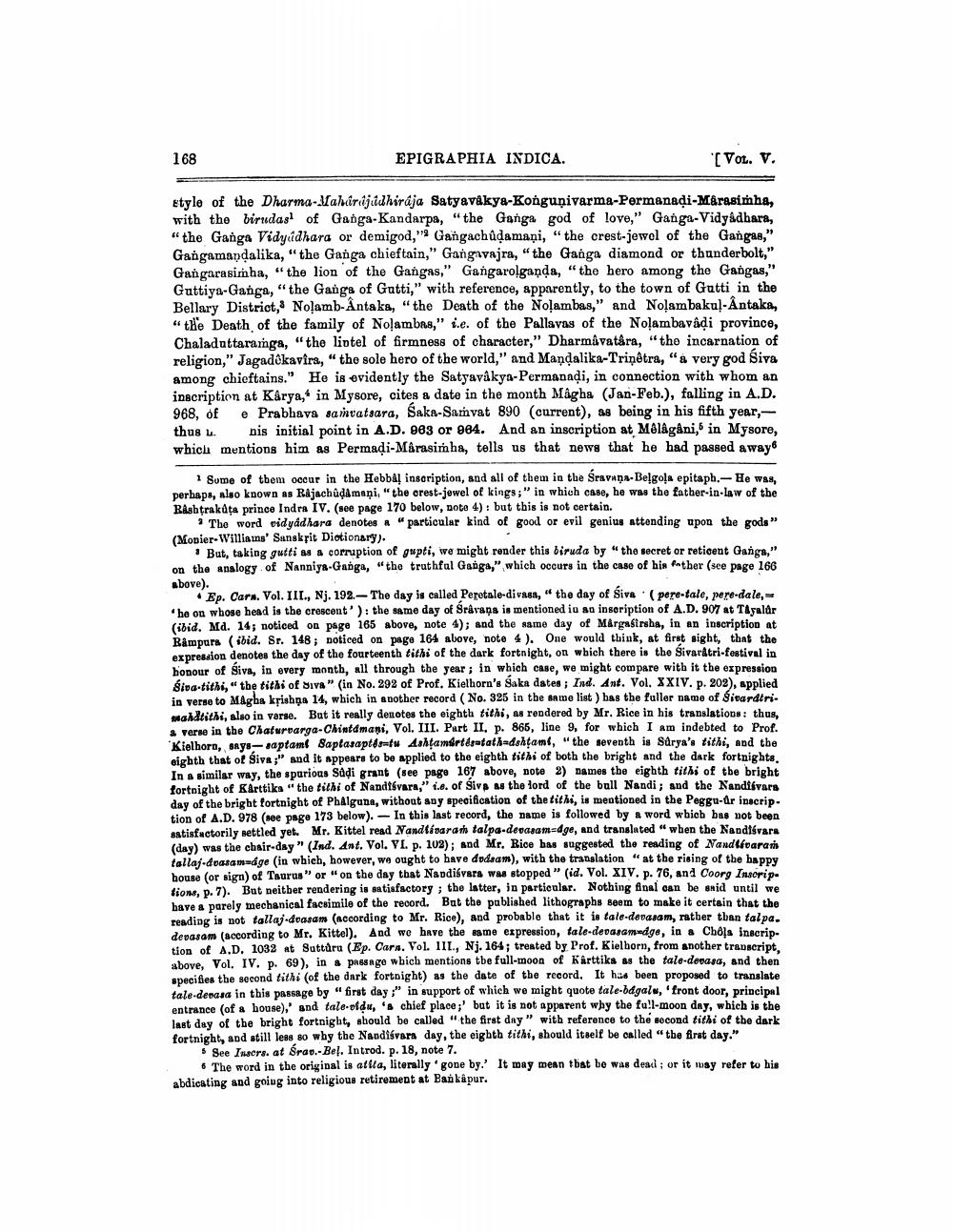________________
168
EPIGRAPHIA INDICA.
(Vor. V.
Etyle of the Dharma-Vahurijidhiraja Satyavákya-Konguņivarma-Permanadi-Marasimha, with the birdasl of Ganga-Kandarpa, “the Ganga god of love," Ganga-Vidyadhara, "the Ganga Vidyadhara or demigod," Gangachûdamani, "the crest-jewel of the Gangas," Gangamandalika," the Ganga chieftain," Gangavajra, "the Ganga diamond or thunderbolt," Gangarasimha, “the lion of the Gangas," Gangarolganda, "the hero among the Gangas," Guttiya-Ganga, "the Gangs of Gutti," with reference, apparently, to the town of Gutti in the Bellary District, Noļamb-Antaka, "the Death of the Noļambas," and Nolambakul-Antaka, "the Death of the family of Nolambra," i.e. of the Pallavas of the Noļambavadi province, Chaladuttaramga, "the lintel of firmness of character," Dharmavatára, "the incarnation of religion," Jagadôkavira," the sole hero of the world," and Mandalika-Triņêtra, "& very god Siva among chieftains." He is evidently the Satyavákya-Permanadi, in connection with whom an inscription at Karya,in Mysore, cites a date in the month Magha (Jan-Feb.), falling in A.D. 968, of Prabhava samvatsara, Saka-Samvat 890 (current), as being in his fifth year, thus . nis initial point in A.D. 983 or 984. And an inscription at Melâgâni, in Mysore, which muntions him as Permadi-Marasimha, tells us that news that he had passed away
1 Some of them occur in the Hebbal inscription, and all of them in the Sravana-Belgola epitaph. He was, perhaps, also known as Rajachůdå maņi," the crest-jewel of kings;" in which case, he was the father-in-law of the Rashtrakata prince Indra IV. (see page 170 below, note 4): but this is not certain.
* The word vidyadhara denotes particular kind of good or evil genius attending upon the gods" (dopier-Williains' Sanskrit Dictionary).
1 But, taking guiti a corruption of gupti, we might render this biruda by "the secret or reticent Gangs." on the analogy of Nanniya-Ganga, "the truthfal Gang," which occurs in the case of his father (see page 166 above).
Ep. Cars. Vol. III., Nj. 192.-The day is called Peretale-divasa," the day of Siva (pere-tale, pere-dale, he on whose head is the crescent'): the same day of Srêvana is mentioned in an inseription of A.D. 907 at Tiyalar (ibid. Ma. 14; noticed on page 165 above, note 4); and the same day of Margasiraba, in an inscription at Råmpura (ibid. Sr. 148 ; noticed on page 164 above, note 4). One would think, at first sight, that the expression denotes the day of the fourteenth tithi of the dark fortnight, on wbich there is the Sivaratri-festival in honour of Siva, in every month, all through the year; in which case, we might compare with it the expression śiva-tithi," the tithi of siva" (in No. 292 of Prof. Kielhorn's Saka dates; Ind. Ant. Vol. XXIV. p. 202), applied in verneto Magha krishna 14, which in another record (No. 325 in the same list ) has the fuller name of Sitardirimaldithi, also in varse. But it really denotes the eighth tithi, as rendered by Mr. Rice in his translations: thus, 2 verse in the Chaturvarga-Chintamani, Vol. III. Part II, p. 865, line 9, for which I am indebted to Prof. Kielhorn, says-saptami Saptasaptasat Ashtamértégatathedshtami, "the seventh is Surya's tithi, and the eighth that of Sive;" and it appears to be applied to the eighth tithi of both the bright and the dark fortnights. In a similar way, the spurious Sadi grant (see page 167 above, noto 2) names the eighth tithi of the bright tortpight of Karttika" the tithi of Nandtsvara," 1.6. of Sivs as the lord of the bull Nandi; and the Nandisvara day of the bright fortnight of PhAlguna, without any specification of the tithi, is mentioned in the Peggu-ar inscrip. tion of A.D. 978 (nee page 173 below). - In this last record, the name is followed by a word wbicb bas not been satisfactorily settled yet. Mr. Kittel read Mandlóarans talpa-devasamadge, and translated "when the Nandiśvare (day) was the chair-day" (Ind. Ant. Vol. VI. p. 102); and Mr. Rice has suggested the reading of Nandkfraran tallaj-duatan dge (in which, however, we ought to have dodam), with the translation "at the rising of the happy house (or sign) of Taurus" or "on the day that Napdiśvers was stopped" (id. Vol. XIV. p. 76, and Coorg Inscrip tions, p. 7). But neither rendering is satisfactory; the latter, in particular. Nothing final can be said until we have a parely mechanical facsimile of the record. But the published lithographs seem to make it certain that the reading is not tallaj-dvasam (according to Mr. Rice), and probable that it is tale-devasam, rather than talpa. devasam (according to Mr. Kittel). And we have the same expression, tale-devasam-edge, in a Chola inscription of A.D. 1032 at Suttúru (Ep. Cars. Vol. III., Nj. 164; treated by Prof. Kielborn, from another transcript, above, Vol. IV. p. 69), in & passage which mentions tbe full-moon of Kárttiks as the tale-donasa, and then specifies the second tithi (of the dark fortnight) as the date of the record. It has been proposed to translate tale-decasa in this passage by "first day :" in support of which we might quote tale-bdgals, 'front door, principal entrance (of a bouse),' and tale-ofdu, 's chief place;' bat it is not apparent why the full-moon day, which is the last day of the bright fortnight, should be called "the first day" with reference to the second tithi of the dark fortnight, and still less so why the Nandisvara day, the eighth tithi, should itself be called "the first day."
See Insers. at Srao.-Bel. Introd. p. 18, note 7.
6 The word in the original is atlla, literally 'gone by. It may mean that he was deaul; or it may refer to his abdicating and going into religious retirement at Bankapur.




